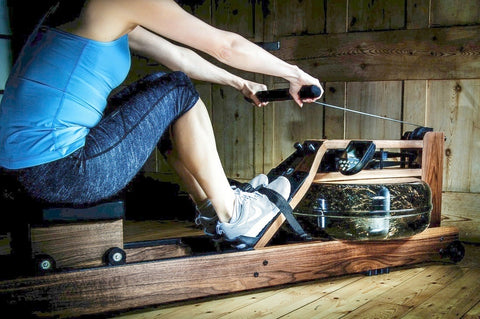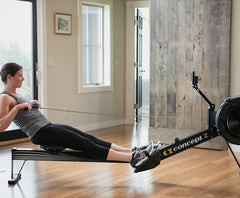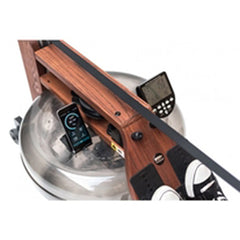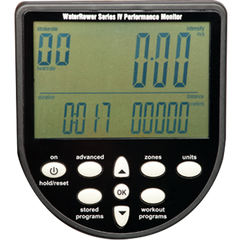The rower is a powerful exercise machine with many benefits and should be considered a serious contender in your shopping experience when you are trying to decide which type of cardio equipment is best for your home. The Journal of the American Medical Association rated the rower as the second most effective exercise machine for burning calories. The #1 machine is still the treadmill.(although ellipticals/cross-trainers were not tested).
The rowing machine is a total body workout, when used with correct form. Your primary muscular engagement is posterior for your upper-body and anterior for your lower body. Your core should be tightened and engaged throughout the entire rhythm of the movement.
Rowing machines are a hot fitness trend, so there's no better time than now to get started.
Ultimate Buyer’s Guide to Home Rowers
Not sure if Rowing is for you?
Check out our Top Ten Reasons to Try Rowing

ROWER RESISTANCE
What are the four types of rowers?
One of the major factors to consider is going to be the type of resistance that the rower utilizes.- Magnetic
- Aerodynamic
- Water
- Hydraulic
For the most part, we are going to concentrate on the three most common systems, which are Air, Magnetic and Water. Hydraulic rowers are still out there . . . and they are commonly a cheap option, however their days are certainly numbered as improvements in quality, bio-mechanics, cost and durability regarding the other three systems are vastly more popular. It’s hard to find a hydraulically controlled rower in a specialty store these days, and the primary reason is because Air, Magnetic and Water rowers are simply and substantially smoother for the user.
Here’s what you need to know about hydraulic rowers:
In addition, because hydraulic rowers use pistons, they tend to heat up very quickly and require a significant amount of maintenance such as oiling. Hydraulic rowers have the advantage of being more compact, and sometimes foldable. They are also normally the cheapest option, and they are usually going to be the ones you see at discount, big-box type department stores. Due to the quality, maintenance and operational smoothness, you aren’t going to see them in specialty stores like G&G Fitness Equipment, and we don’t recommend them.
That being said, let’s talk about the types of rowers we certainly do recommend, and break down their benefits.
AIR Resistance Rowers
It is hard to say that air is definitively the most common system today, as other systems have chunked their place into the market and businesses such as Orange Theory grow trendy. In years past however, it certainly has been the case that the aerodynamic rower was the optimal choice.
 The Concept 2 is the quintessential “Model T” of rowing machines, and there is good reason. If you have ever used or walked by a rower in a health club, there is a solid probability that it was a Concept 2. Why? In short, they are absolute tanks, and they will hold up to the abuse of being used by numerous users 24 hours per day, 7 days per week, 365 days per year with little service issues.
The Concept 2 is the quintessential “Model T” of rowing machines, and there is good reason. If you have ever used or walked by a rower in a health club, there is a solid probability that it was a Concept 2. Why? In short, they are absolute tanks, and they will hold up to the abuse of being used by numerous users 24 hours per day, 7 days per week, 365 days per year with little service issues.
The Concept 2 is one of the most common air rowing machines you will hear about and is especially popular today with Crossfitters, but there are many air-resistance rowers to choose from, and while they are going to have numerous differences in other categories, the air system is universally similar in terms of overall functionality and benefits.
The aerodynamic resistance system is painfully simple, which is one big reason why they hardly ever fail or break down. Inside the wheel housing is a flywheel with fan-blades that are angled, and that angle can be adjusted with the flip of a lever, switch or knob. The higher level you set the rower at, the more angular the blades become, making it more difficult for air to pass through when the user pulls or the chain or belt. The harder it is for air to pass through, the more resistance there is! When you combine this with your stroke, you should feel a smooth resistance.
Rowers with Magnetic Resistance
While magnetic resistance is the most common type of resistance system on modern ellipticals and bikes, it isn’t quite as popular on rowing machines. This isn’t a good or bad thing; it is just a product of the offerings in the industry combined with the obvious differences of a rower’s movement versus pedaling a bike or cross-trainer.
Magnetic rowers are going to usually be the quietest rowers you will find.
There isn’t a large fan moving air or large blades pushing water, so your experience is going to be significantly quieter. Like bikes and ellipticals, there are normally magnets that are variable in distance to the flywheel. The higher you set the resistance (using a knob, lever or console button) the closer the magnets will be to the wheel. The closer the magnets are, the harder it is to turn. It is static; you set a level, and it stays at that level until you change it again. Your stroke isn’t going to have as much of an effect on the resistance as an air or water rower, because you aren’t creating any drag with air or water.
Sometimes, magnets can be combined with air to give even more powerful resistance, such as the Bodycraft VR500.
WATER Resistance Rowers
Water resistance rowers aren’t a new idea, but they are newly popular in the home market. They are somewhat incorrectly classified as the most enigmatic system for consumers that are just starting out their shopping experience, and personally, I think the reason for this is simply the penchant for how a new purchaser has been told or suggested as to how resistance is supposed to be.
Water resistance rowers are closer to a rowing simulator than the other systems.
That is largely because you are pushing water. The biggest difference between a water rower and an air or magnetic rower is that the resistance is dynamic, and not static. It’s somewhat of an antithesis, and you are not going to be turning a knob or lever or pressing a button on a control panel to lower or increase your resistance.
 Instead, you turn paddles in a large tank of water, which creates drag and produces resistance. It is the most dynamic system of all. The resistance is extremely smooth and consistent, and unlike air or magnetic rowers, you are not going to have a “dead spot” during the transition from one stroke into the next. Another reason why this system is so smooth, is pushing water is more adaptive. As you engage more muscles when you get closer to your chest through the stroke, it is gets harder to push the water. If you regularly kayak, you are going to have a much more similar experience pushing actual water with your indoor training.
Instead, you turn paddles in a large tank of water, which creates drag and produces resistance. It is the most dynamic system of all. The resistance is extremely smooth and consistent, and unlike air or magnetic rowers, you are not going to have a “dead spot” during the transition from one stroke into the next. Another reason why this system is so smooth, is pushing water is more adaptive. As you engage more muscles when you get closer to your chest through the stroke, it is gets harder to push the water. If you regularly kayak, you are going to have a much more similar experience pushing actual water with your indoor training.
What about maintenance? Well, for the most part, there’s not much. WaterRower provides a lifetime supply of chlorine tablets for you to place in your tank every few months to keep the water clean. The tank is also sealed, so there’s isn’t going to be any constant refilling. You also don’t need to be changing the water level regularly, either. I would venture to say that there is about as much time and effort required to maintain a water tank as there is to maintain a chain driven machine.
WHICH HOME ROWER IS BEST?
Well, this is completely subjective. I don’t think any of them is the “best,” but they all do have their advantages, and when you speak to your expert fitness consultant, they will be able to help you determine which one works best for you. If you are looking for the quietest option, maybe magnetic is best, like the Inspire Crossrower. Smoothest? Go for the WaterRower. Most resistance possible? Maybe consider the air/magnet combo like the VR500. The point is to explore these things with your fitness consultant, and absolutely to try them all out!
CHAIN vs. BELT
Some rowers have chains connected to the wheel and handle, and some have belts. What’s the difference?
Chains are going to be stronger and more durable. Chains are also going to be noisier and require maintenance, in the form of routine lubrication.
Belts aren’t quite as strong as chains (even though they are still extremely strong), and belts are going to be less noisy. Belts won’t require any maintenance, either. If the belt is protruding from a cavity, you want to be careful not to let the edges of the belt rub against the grommet, because over time, the friction could result in the belt fraying. Some machines do not feed the belt through a shroud, and will not create the opportunity for the belt to fray.
THE FRAME
Some rowers are steel. Some are wood. What’s the difference?
Steel and aluminum frames are typically more common in commercial environments. This is because it they are extremely cost effective and hold up well in high use and competitive settings with little attention required.
Wood frames are more common on water rowers. Wood frames tend to look much more elegant and can be significantly quieter. Other than the usual cleaning, they require little care and are extremely durable; the maximum user weight on a WaterRower is 1000 pounds!
SPACE
If space is a concern for you, there are many options! Some rowers, like the Bodycraft VR200, are foldable. WaterRowers are designed to be stood upright. The Concept 2 breaks into two, separate pieces. When you visit a G&G Fitness Equipment showroom, have your consultant show you how each rowing machine can be stowed to optimize your space.
FEATURES
Rowers are manual workouts, and the machine is not controlled by a computer, such as a treadmill. Still, rowing machines have great features to choose from.
 Most standard computers that come with rowing machines are going to track your essential workout metrics, such as distance (typically in meters), time, calories, heart rate, watts, etc. These screens are usually HUD’s or LCD displays. If the rower is magnetic, or air/magnet combination, you likely will be able to change your resistance with the panel itself, or there may even be button controls on the handles.
Most standard computers that come with rowing machines are going to track your essential workout metrics, such as distance (typically in meters), time, calories, heart rate, watts, etc. These screens are usually HUD’s or LCD displays. If the rower is magnetic, or air/magnet combination, you likely will be able to change your resistance with the panel itself, or there may even be button controls on the handles.
I think that workout variability is essential, so you should also consider any external accessories that enhance your experience such as Smartrow. Talk to your consultant about what options are out there that fit your needs best.
CONCLUSION
The rowing machine is an excellent workout that does not take up much space in the home, is easy on your joints and is fun and engaging. It is highly efficient and can save you time and money, when compared to other options Not all rowers are made the same, however . . . and you should take the time to consider which option(s) fit your needs best. My experience indicates that clients who purchase equipment without first trying it out for themselves, are less likely to use the equipment over the long term. Stop by a G&G Fitness near you and try out our selection of rowing machines, and let one of our consultants help you find the perfect machine for you and your home.
Are you ready to try indoor rowing? Have any questions? Chat with us or leave us a comment.
Try our Virtual Rower Assistant


2 comments
Great article and very helpful. Thank you
Thank you so much for this guide! Now I feel like I know what to look for when i go rower shopping. You made it easy to understand.